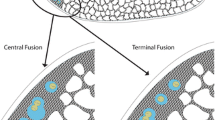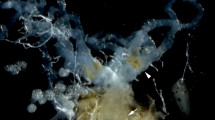Abstract
The stick insects Bacillus rossius-grandii benazzii and B. rossius-grandii grandii naturally reproduce by hybridogenesis and androgenesis. The hybrid karyotype of the former (2n=35, XX female; 34, X0 male) clearly sums up a B. rossius haploset (r) with n=18 and a B. grandii benazzii one (gb) with n=17. The two sets keep the parental features for C-heterochromatin amount (much larger in the gb complement) and satellites/NORs (nuclear organizer regions) (more numerous and variably located in the r set); hybridogenetically produced males always show severely impaired gametogenesis and are therefore sterile, whereas hybridogenetic females are fertile. Reproductive, karyological and cytogenetical properties of the hybridogenetic system have been exploited to obtain the chromosomal evidence of whole haploset exchanges. In progenies obtained by crossing B. rossiusgrandii benazzii females to B. rossius males with either standard or repatterned (with Robertsonian fusions) karyotypes, there has always been complete agreement between electrophoretically genotyped and karyologically analyzed hybridogenetic offspring: the unassorted maternal r haploset (r m) is transmitted and the gb m haploset replaced by that of the fathering male (r p), thus evidencing the hemiclonal reproduction and the new r m-r p chromosomal constitution. New karyotype traits of the offspring relate to chromosome number (2n=36, female; 35, male), C-heterochromatin pattern (the heterochromatin-rich gb haploset completely disappears) and satellite/NOR features (corresponding to r m plus r p locations). The same crosses also produce genetically and chromosomally all-paternal descendants (androgenetics), of both sexes and fully fertile, with an r p r p structure. These androgenetic progeny show segregation for alleles and chromosomes at which fathering males are heterozygous: it was therefore possible to demonstrate that androgenetics can derive from syngamy of two sperm nuclei, of the several present in the polyspermic hybridogenetic egg. The production of androgenetics from field fertilized females of B. rossius-grandii benazzii, B. rossius-grandii grandii and parthenogenetic Bacillus whitei (=B. rossius/grandii grandii) suggests the occurrence of unsuspected relationships between hybrids and their parental species, so that the hybrids cannot be simply considered as ‘sexual parasites’. Furthermore, there is a suggestion of evolution of parthenogenetic clonal species from selection of initially hybridogenetic strains. The ability to produce uniparental progeny naturally from the spermatic genome may open a new field of investigation on genomic imprinting.
Similar content being viewed by others
References
Benazzi M, Formenti D, Manfredi Romanini MG, Pellicciari C, Redi CA (1981) Feulgen-DNA content and C-banding of robertsonian transformed karyotypes in Dugesia lugubris. Caryologia 34:129–139
Bucci S, Ragghianti M, Mancino G, Berger L, Hotz H, Uzzell TM (1990) Lampbrush and mitotic chromosomes of the hemiclonally reproducing hybrid Rana esculenta and its parental species. J Exp Zool 255:37–56
Bullini L, Nascetti G (1990) Speciation by hybridization in phasmids and other insects. Can J Zool 68:1747–1760
Cimino MC (1972) Egg-production, polyploidization and evolution in a diploid all-female fish of the genus Poeciliopsis. Evolution 26:294–306
Coyne JA (1985) The genetic basis of Haldane's rule. Nature 314:736–738
Coyne JA (1992) Genetics and speciation. Nature 355:511–515
Cuellar O (1976) Cytology of meiosis in the triploid gynogenetic salamander Ambystoma tremblay. Chromosoma 58:355–364
Dawley RM (1989) An introduction to unisexual vertebrates. In: Dawley RM, Bogart JP (eds) Evolution and ecology of unisexual vertebrates. New York State Museum Press, Albany, NY, USA, pp 1–18
Dawley RM, Bogart JP (1989) Evolution and ecology of unisexual vertebrates. New York State Museum Press, Albany, NY, USA
Downs FL (1978) Unisexual Ambystoma from the Bass Islands of Lake Eire. Occas Pap Mus Zool Univ Mich 685:1–36
Giorgi P (1992) Sex and the male stick insect. Nature 357:444–445
Hedges SB, Bogart JP, Maxson LR (1992) Ancestry of unisexual salamanders. Nature 356:708–710
Howell WM, Black DA (1980) Controlled silver-staining of nucleolus organizer regions with a protective colloidal developer: a 1-step method. Experientia 36:1014–1015
Keegan-Rogers V, Schultz RJ (1988) Sexual selection among clones of unisexual fish (Poeciliopsis: Poeciliidae): genetic factors and rare-female advantage. Am Nat 132:846–868
Macgregor HC, Uzzell TM (1964) Gynogenesis in salamanders related to Ambystoma jeffersonianum. Science 143:1043–1045
Manaresi S, Marescalchi O, Scali V (1991) Ag-detected NOR and C-banding patterns in Bacillus rossius (Insecta Phasmatodea) from Sicily. Caryologia 44:265–286
Manaresi S, Marescalchi O, Scali V (1992a) The chromosome complement of the hybrid Bacillus whitei complex (Insecta Phasmatodea). I. The paleo- and neo-standard karyotypes. Cytologia 57:101–109
Manaresi S, Marescalchi O, Scali V (1992b) The chromosome complement of the hybrid Bacillus whitei complex (Insecta Phasmatodea). II. The repatterned cytotypes. Cytologia 57:111–119
Mantovani B, Scali V (1990) Preliminary report on a hybridogenetic stick-insect (Phasmatodea): the first case among invertebrates. Invertebrate Reprod Dev 18:185–188
Mantovani B, Scali V (1992) Hybridogenesis and androgenesis in the stick insect Bacillus rossius-grandii benazzii (Insecta Phasmatodea). Evolution 46:783–796
Mantovani B, Scali V, Tinti F (1991) Allozyme analysis and phyletic relationships of two new stick-insects from north-west Sicily: Bacillus grandii benazzii and B. rossius-grandii benazzii (Insecta Phasmatodea). J Evol Biol 4:279–290
Marescalchi O (1989) Aspetti citologici della biologia riproduttiva, differenziamento cromosomico ed ibridazione nel genere Bacillus Latreille (Insecta Phasmatodea). Thesis of Dottorato di Ricerca, University of Bologna
Marescalchi O, Scali V (1990) Cytogenetic studies on Bacillus grandii grandii and Bacillus grandii benazzii (Insecta Phasmatodea): karyotype description, constitutive heterochromatin and nucleolus organizer regions. Genetica 82:117–124
Monk M (1988) Genomic imprinting. Genes Dev 2:921–925
Moritz C, Brown WM, Densmore LD, Wright JW, Vyas D, Donnellan S, Adams M, Baverstock PR (1989) Genetic diversity and the dynamics of hybrid parthenogenesis in Cnemidophorus (Teiidae) and Heteronotia (Gekkonidae). In: Dawley RM, Bogart JP (eds) Evolution and ecology of unisexual vertebrates. New York State Museum Press, Albany, NY, USA, pp 87–112
Moritz C, Uzzell T, Spolsky C, Hotz H, Darevsky I, Kupriyanova L, Danielyan F (1992) The material ancestry and approximate age of parthenogenetic species of Caucasian rock lizards (Lacerta: Lacertidae). Genetica 87:53–62
Paterson HEH (1985) The recognition concept of species. In: Vrba ES (ed) Species and speciation. Transvaal Museum Monograph No 4, Transvaal Museum, Pretoria, pp 21–29
Quattro JM, Avise JC, Vrijenhoek RC (1992) An ancient clonal lineage in the fish genus Poeciliopsis (Atheriniformes: Poeciliidae). Proc Natl Acad Sci USA 89:348–352
Scali V (1991) Un nuovo insetto stecco (Phasmatodea) della Sicilia: Bacillus grandii benazzii (n. subsp.). Frustula Entomologica NS (1989) 12:397–408
Scali V, Tinti F (1992) Rapid assessment of maturation stage and reproductive mode in centrolecytic eggs of stick-insects (Insecta Phasmatodea). Biotechnic Histochem 67:356–359
Scali V, Mantovani B, Tinti F (1991) Primi dati sull'ibridogenesi, androgenesi e ginogenesi di Bacillus whitei Nascetti e Bullini (Insecta Phasmatodea). Frustula entomologica NS (1989) 12:103–108
Scali V, Tinti F, Mantovani B (1992) From bisexual to unisexual organisms: the case of Bacillus whitei. In: Dallai R (ed) Sex origin and evolution. (Selected Symposia and Monographs UZI, 6) Mucchi, Modena, pp 353–368
Schultz RJ (1961) Reproductive mechanisms of unisexual and bisexual strains of the viviparous fish Poeciliopsis. Evolution 15:302–325
Schultz RJ (1967) Gynogenesis and triploidy in the viviparous fish Poeciliopsis. Science 157:1564–1567
Schultz RJ (1969) Hybridization, unisexuality, and polyploidy in the teleost Poeciliopsis (Poeciliidae) and other vertebrates. Am Nat 103:605–619
Schultz RJ (1977) Evolution and ecology of unisexual fishes. Evol Biol 10:277–331
Schultz RJ (1980) Role of polyploidy in the evolution of fishes. In: Lewis WH (ed) Polyploidy: biological relevance. Plenum Press, New York, pp 313–340
Schultz RJ (1989) Origins and relationships of unisexual Poeciliids. In: Meffe SK, Snelson FF (eds) Ecology and evolution of livebearing fishes. Prentice Hall, pp 69–87
Spolsky CM, Phillips CA, Uzzell T (1992) Antiquity of clonal salamander lineages revealed by mitochondrial DNA. Nature 356:706–708
Tinti F (1993) Morphological, genetic and chromosomal characterization of Corsican and Spanish Bacillus rossius (Insecta Phasmatodea). Vie Milieu, in press
Tinti F, Scali V (1990) Polimorfismi cromosomici in Bacillus rossius (Rossi) e B. atticus Brunner della Sardegna (Insecta Phasmatodea). 53° Congr UZI, Palermo 1–5 Ottobre 1990. Mucchi, Modena, pp 339–340
Tinti F, Scali V (1991) C-banding, Ag-NOR localization and chromosomal repatterning in Sardinian Bacillus atticus (Insecta Phasmatodea). Boll Zool 58:235–243
Tinti F, Scali V (1992) Genome exclusion and gametic DAPI-DNA content in the hybridogenetic Bacillus rossius-grandii benazzii complex (Insecta Phasmatodea). Mol Reprod Dev 33:235–242
Tinti F, Mantovani B, Scali V (1992) Caratterizzazione allozimatica di popolazioni di Bacillus rossius dell'Italia centro-meridionale e della Sicilia (Phasmatodea). Boll Soc Ent Ital 123:184–194
Tunner HG (1973) Das Albumin und andere Bluteiweisse bei Rana ridibunda Pallas, Rana lessonae Camerano, Rana esculenta Linné und deren Hybriden. Z Zool Syst Evol Forsch 11:219–233
Tunner HG (1974) Die klonale Struktur einer Wasserfroschpopulation. Z Zool Syst Evol Forsch 12:309–314
Tunner HG, Heppich-Tunner S (1991) Genome exclusion and two strategies of chromosome duplication in oogenesis of hybrid frog. Naturwissenschaften 78:32–34
Turner BJ, Steeves RH (1989) Induction of spermatogenesis in an all-female fish species by treatment with an exogenous androgen. In: Dawley RM, Bogart JP (eds) Evolution and ecology of unisexual vertebrates. New York State Museum Press, Albany, NY, USA, pp 113–122
Turner BJ, Balsano JS, Monaco PJ, Rasch EM (1983) Clonal diversity and evolutionary dynamics in a diploid-triploid breeding complex of unisexual fishes (Poecilia). Evolution 37:798–809
Uzzell TM (1963) Natural triploidy in salamanders related to Ambystoma jeffersonianum. Science 139:113–115
Uzzell TM (1964) Relations of the diploid and triploid species of the Ambystoma jeffersonianum complex (Amphibia, Caudata). Copeia, pp 257–300
Uzzell T, Berger L (1975) Electrophoretic phenotypes of Rana ridibunda, Rana lessonae, and their hybridogenetic associate, Rana esculenta. Proc Acad Nat Sci Philadelphia 127:13–24
Uzzell TM, Goldblatt SM (1967) Serum proteins of Salamanders of the Ambystoma jeffersonianum complex and the origin of triploid species of this group. Evolution 21:345–354
Uzzell T, Hotz H, Berger L (1980) Genome exclusion in gametogenesis by an interspecific Rana hybrid: evidence from electrophoresis of individual oocytes. J Exp Zool 214:251–259
Vrijenhoek RC (1979) Factors affecting clonal diversity and coexistence. Am Zool 19:787–797
Vrijenhoek RC, Schultz RJ (1974) Evolution of a trihybrid unisexual fish (Poeciliopsis, Poecilidae). Evolution 28:306–319
Vrijenhoek RC, Dawley RM, Cole CJ, Bogart JP (1989) A list of the known unisexual vertebrates. In: Dawley RM, Bogart JP (eds) Evolution and ecology of unisexual vertebrates, New York State Museum Press, Albany, NY, USA, pp 19–23
Willard HF (1990) Centromeres of mammalian chromosomes. Trends Genet 6:410–416
Yen TJ, Compton DA, Wise D, Zinkowski RP, Brinkley BR, Earnshaw WC, Cleveland DW (1991) CENP-E, a novel human centromere-associated protein required for progression from metaphase to anaphase. EMBO J 10:1245–1254
Author information
Authors and Affiliations
Additional information
Communicated by: H.C. Macgregor
Rights and permissions
About this article
Cite this article
Tinti, F., Scali, V. Chromosomal evidence of hemiclonal and all-paternal offspring production in Bacillus rossius-grandii benazzii (Insecta Phasmatodea). Chromosoma 102, 403–414 (1993). https://doi.org/10.1007/BF00360405
Received:
Revised:
Accepted:
Issue Date:
DOI: https://doi.org/10.1007/BF00360405




